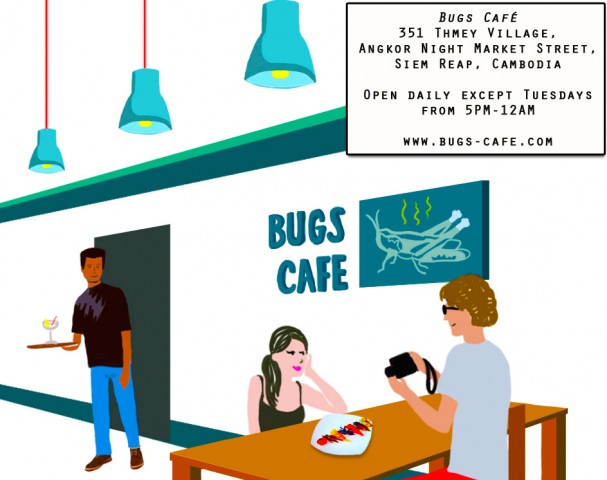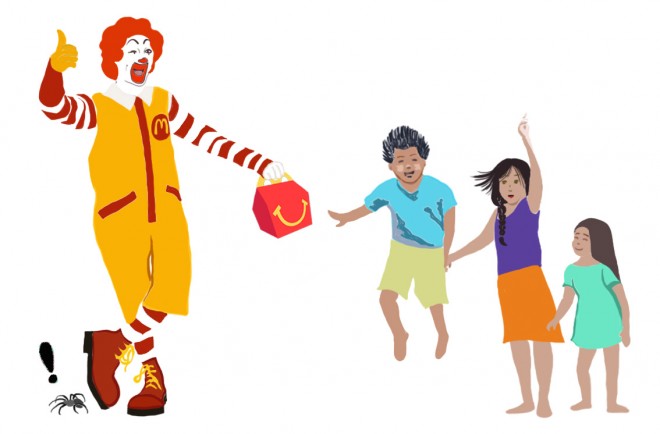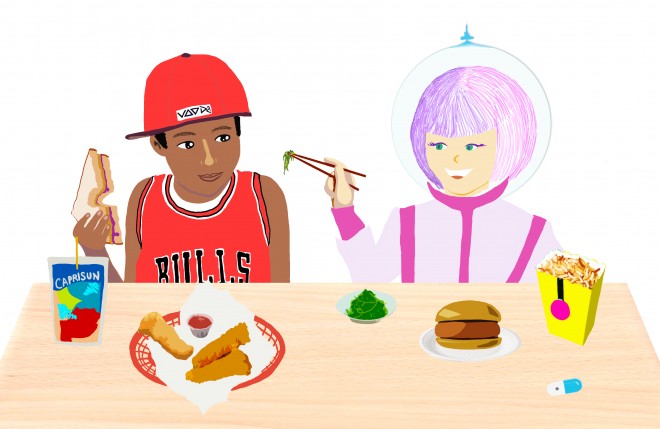Bugs are the future. Image by Sammi Lim.
My mouth turns dry as the waiter lays out our spread; ironic, considering what lies before us is deemed a right royal feast to the locals. Patrick and I stare bug-eyed at our sampler platter: ant-stuffed spring rolls, a giant insect skewer, tarantula samosas, and wok-fried crickets and silk worms. I’d been abuzz about sampling creepy crawly cuisine in Cambodia, but I sure feel like bugging out now.
I decide to swallow my fears (literally).
Taste verdict: Tarantula* is, by far, the best tasting of the lot. I enjoyed the various textures found in their crunchy, spindly legs and rich, creamy bodies. It was a nuisance to eat any winged insects, as their plastic-y wings get stuck in your teeth. Worms are no biggie, though waterbugs carry a stink worse than garlic.
*Technically an arachnid, but entomophagy encompasses other creepy crawlies such as spiders and scorpions.
I’ve definitely had worse-tasting “regular” food.

Dinner at Bugs Café in Siem Reap, Cambodia was one of my most memorable meals on the road! Image by Sammi Lim.
It’s a Bug’s Life
Why are people eating insects? Is it to economize?
To some extent, yes. Sure, caterpillar is cheaper than chicken, but in some parts of the world, eating bugs isn’t a matter of being thrifty – it’s a real means of survival.
Take Ghana, for instance: The country’s subtropical climate means that when it rains, it pours, especially in May and June. Too much humidity leads to two things: poor crops and the seasonal appearance of pesky termites. Ghanaians use common sense to make do, substituting termites for lost produce. Treasured as a valuable source of protein in Ghana, termites are typically roasted, fried, and baked into bread.

Fast food or flying mantises? Which is really worse for your health? Image by Sammi Lim.
Is it a trend or a tradition?
A bit of both, actually.
Gross but cool fact: Fossilized human feces containing bits of bugs proves that people have been subsisting on a diet of insects since prehistoric times.
Also, the Bible describes St. John the Baptist as having survived on a diet of locusts and honey in the desert.
Two billion people on the planet – predominantly from Australia, Brazil, China, Ghana, Japan, Mexico, and Thailand – indulge in insects. However, insect consumption in developing countries has significantly diminished with the introduction of Western franchises worldwide. McDonald’s is one such culprit. This is quite unsurprising — I can think of few five-year-olds who would choose a bowl of mealworms over a Happy Meal.
That being said, a rising food movement has peaked interest in entomophagy (the consumption of insects). Bugs are making a comeback, whether it’s as street food or haute cuisine. Curious chefs enjoy experimenting with the flavors and textures of bugs, and daring gourmets relish the “novelty” of consuming something taboo.
Are bugs healthy for you?
Extremely.
Practitioners of diet fads, rejoice! Bugs totally cater to the Paleo Diet. Low in fat and high in protein, insects are a health nut’s dream. They’re also packed with essential minerals, fiber, and vitamins.
A diet of insects isn’t just good for you; it also does wonders for Mother Nature.
Did you know that when it comes to common livestock such as cows, chickens, and pigs, only 50 percent of their full body mass is edible? On the other hand, 80 percent of a bug’s full body mass effectively goes to our bellies, eliminating a huge amount of waste.
Bug farms are astoundingly more efficient than other animal farms. They take up less land, require smaller quantities of feed and water, produce fewer greenhouse gasses, and leave significantly smaller carbon footprints, all for the same amount of protein. A commercial bug diet could also eliminate caged farming and other inhumane agricultural methods.
Do bugs actually taste good?
It really comes down to individual taste, but, as I mentioned earlier, I find tarantula delicious! Once you dispense of the idea that bugs are gross, a whole palate of possibilities opens up.

What will your kids and their kids be eating in 3015? Here’s a wild guess: kelp salad, lab-grown burgers, mealworm popcorn, and capsule water. Image by Sammi Lim.
The Future of Food
The Food and Agriculture Organization of the United Nations (FAO) is pushing for the popularization of entomophagy to meet the needs of a rapidly growing world population. While insects have long been farmed as animal feed, the future will see an increase in insect farms catering exclusively to humans!
Still unconvinced? Chew on this: Americans consume approximately two pounds of insects annually. The U.S. Food and Drug Administration has decreed that a certain amount of insect parts is permitted in vegetables, grains, beer, etc. So what’s the big deal with eating them intentionally?
For more cool information, check out National Geographic’s feature on edible insects.
